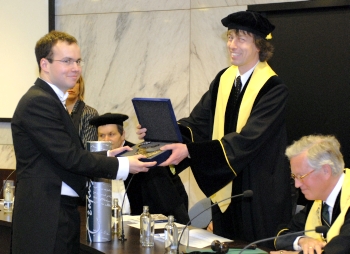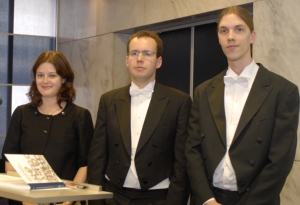Cum Laude PhD Defense Joost van Rosmalen
 On April 9, Joost van Rosmalen has defended his PhD thesis entitled “<link erim events _blank>Segmentation and Dimension Reduction: Exploratory and Model-Based Approaches”. The dissertation of Van Rosmalen is about developing new statistical techniques that can be used to summarize and visualize the information in a data set. In the thesis, he focuses on two types of statistical techniques. The first technique is dimension reduction, which tries to reduce the complexity of the data by identifying underlying dimensions or factors. These factors or dimensions can be used to visualize and help explain the data. The second technique is clustering, which divides the observations into a limited number of homogeneous groups (clusters). Van Rosmalen specifically focuses on two-mode clustering, in which the rows and columns of a data matrix are assigned to clusters simultaneously. He obtained his degree Cum Laude.
On April 9, Joost van Rosmalen has defended his PhD thesis entitled “<link erim events _blank>Segmentation and Dimension Reduction: Exploratory and Model-Based Approaches”. The dissertation of Van Rosmalen is about developing new statistical techniques that can be used to summarize and visualize the information in a data set. In the thesis, he focuses on two types of statistical techniques. The first technique is dimension reduction, which tries to reduce the complexity of the data by identifying underlying dimensions or factors. These factors or dimensions can be used to visualize and help explain the data. The second technique is clustering, which divides the observations into a limited number of homogeneous groups (clusters). Van Rosmalen specifically focuses on two-mode clustering, in which the rows and columns of a data matrix are assigned to clusters simultaneously. He obtained his degree Cum Laude.
To illustrate the usefulness of these techniques, the thesis includes a variety of empirical applications that can provide meaningful insight to researchers and marketing practitioners. For example, the application on modeling response styles in rating scale surveys shows how respondents can vary in the way they use rating scales. There are large differences in the level of positivity and extremity that respondents show in their answers, irrespective of the content of the items in the survey. Using a new statistical model, Van Rosmalen can identify all kinds of response styles, including response styles that have not been reported previously. He also finds that a large amount of the differences in response styles can be attributed to cultural factors and characteristics such as age and level of education. As a result, differences in average scores between countries may not reflect actual differences in opinion; therefore, marketing practitioners should be careful when comparing survey results of different countries. The modeling approaches presented in this dissertation yield new techniques for data analysis that can be useful in a variety of applied fields.
His promotor is <link people patrick-groenen _blank>Prof.dr. P.J.F. Groenen, Professor of Statistics, Erasmus School of Economics, Erasmus University Rotterdam. His co-promotor is Dr. A.J. Koning. Other members of the Doctoral Committee are Prof.dr. R. Paap, Prof.dr.ir. A. Smidts and Prof.dr. J.K. Vermunt.
About Joost van Rosmalen:
Joost van Rosmalen (1982) obtained his master's degree in Econometrics and Management Science with honors from Erasmus University Rotterdam in 2004. In the same year, he started his PhD research. His main research interests are in quantitative marketing research, psychometrics, and econometrics. His research has been presented at several international conferences and has resulted in several papers, of which three have been accepted for publication in Journal of Classification, Journal of Marketing Research, and Multivariate Behavioral Research.
 Abstract:
Abstract:
Representing the information in a data set in a concise way is an important part of data analysis. A variety of multivariate statistical techniques have been developed for this purpose, such as k-means clustering and principal components analysis. These techniques are often based on the principles of segmentation (partitioning the observations into distinct groups) and dimension reduction (constructing a low-dimensional representation of a data set). However, such techniques typically make no statistical assumptions on the process that generates the data; as a result, the statistical significance of the results is often unknown.
In this thesis, we incorporate the modeling principles of segmentation and dimension reduction into statistical models. We thus develop new models that can summarize and explain the information in a data set in a simple way. The focus is on dimension reduction using bilinear parameter structures and techniques for clustering both modes of a two-mode data matrix. To illustrate the usefulness of the techniques, the thesis includes a variety of empirical applications in marketing, psychometrics, and political science. An important application is modeling the response behavior in surveys with rating scales, which provides novel insight into what kinds of response styles exist, and how substantive opinions vary among respondents. We find that our modeling approaches yield new techniques for data analysis that can be useful in a variety of applied fields.
More Information
Pictures of the Defense
Full Text of the Dissertation


